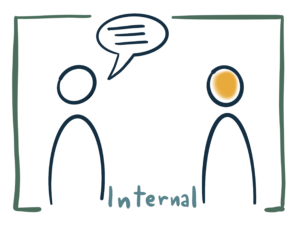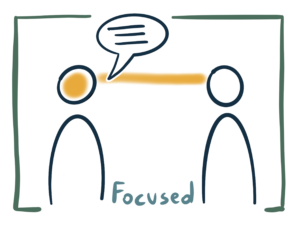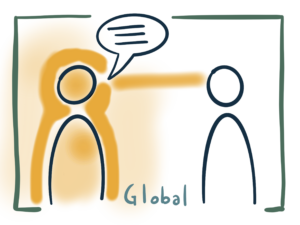Deeper listening levels can be more powerful than loud words
Posted By - Frankie Bianchi

“And they will think you are brilliant. They will thank you. You will feel you did nothing, but you will have given life. Like the sun, you will just have come out and beamed. That was all. And look what happened”
This is how Nancy Kline described the deep power of listening levels in her book Time to Think.
Listening carefully. Unconditionally. With curiosity. With respect.
Nancy doesn’t focus on the listening done in the way we are used to. I would almost say “in the way we are taught to”. Nancy describes the effect of a type of listening that sits on a different level. Listening levels 2 & 3 specifically 😉
It all starts at Listening Level 1…
As humans our attention span is extremely short. While it has not been scientifically proven yet, the consensus is that as humans living in modern times our attention span has decreased to unprecedentedly low levels (https://www.eurekalert.org/news-releases/490177).
We know that a new thought arises in our heads every 15 seconds or so (https://www.healthline.com/health/how-many-thoughts-per-day#thoughts-per-day). To the natural flow of ideas we now must add the continuous interruptions of notifications from emails, instant messages, social media and calendar reminders. The extremely fast pace of our lives got us tricked into accepting constant multi-tasking as the natural way of living. We are almost necessarily required to stay on a dozen active threads simultaneously. Reply to that message, now check the email, cool I’ve reached inbox zero, but did they react to my post on Linkedin? Let me reload the page to see. Oh wait, John wants to talk about that important project but I only have 3 minutes before my next call. Maybe I can get him to agree to take that key decision while I multi-task from that call? The call is recorded anyway and I can always watch it back if I miss something that feels important.
We swap our attention so often that we are now conditioned to do it even when it’s not needed.
We can shield our thinking from those interruptions but our resilience has dropped to 10-15 minutes max and only if we are extremely intentional about it and have enough energy to dedicate to maintenance of focus (see for example https://www.independent.co.uk/news/uk/home-news/attention-span-average-british-person-tuned-in-concentration-mobile-phone-a8131156.html & https://journals.physiology.org/doi/full/10.1152/advan.00109.2016).
When we talk to someone, especially if outside of a work context, we are usually not that intentional and may easily be tired. When we chat with our friends or family members we are typically exhausted from a long day of “resistance to distraction”. We have given attention to others and to work and now need some time for us.
So as soon as the conversation starts and after a few seconds when the first thought comes to our mind, we typically let our mind wander and follow it. At 4 thoughts per minute, that’s the equivalent of real internal chattering and we focus our attention on it. “Does she include me in that statement?”. “Oh, nice idea for a movie. I need to remember to put it on my watchlist”. “That would have never happened to me. I know how to deal with Jack whenever he tries something similar”. “Oh, I know how to solve that. That’s easy. Let me interrupt her so I can help her but also close the topic quickly so that we can finally focus our conversation on what happened to me today, which is much more interesting and important!”
When we chat with someone, we generally listen at level 1. That’s called Internal Listening. That’s good enough, most of the time. That’s what feels normal to most people, and most of the time that’s what people expect to experience as it helps create a flow of conversation rather than a monologue.
This type of listening also requires a small amount of energy from us and allows more space for energy from the other party/parties.
However, it’s not ideal if we want to encourage those parties to think deeply.

… If we want things to get interesting, we need to push ourselves to Listening Level 2
To solve most non trivial problems we need to think. Deeply. To do high quality work that we have not already done a gazillion times before, we need to think. To evaluate a situation, a framework, a human relationship that is not working we need to think.
A way I like to define thinking is
“as our ability to have an internal dialogue where we listen to ourselves”
And as I’ve highlighted above, I think we can agree that today more than ever it’s increasingly hard to people to stop and think.
This can be made easier if done together with someone who helps us keep our focus and attention. Nancy calls this person a “Thinking Partner”. The mere act of talking out loud about something is already valuable as it involves more senses and as a consequence that already helps shield ourselves from our internal noise.
But what would happen if the person whom we have chosen as a Thinking Partner interrupted us every few seconds to share their opinion? How disruptive would that be? How different from our internal chattering?
“To be interrupted is not good. To get lucky and not be interrupted is better. But to know you are not going to be interrupted – that is categorically different. That is bliss.“
continues Nancy.
That’s why it’s important that we choose someone who knows how to move from listening levels 1 to 2, where we encounter Focused Listening.
As listeners, being able to resist the temptation to let our mind wander off is critical. As it’s critical to carefully evaluate why we want to ask that question. Is it to satisfy my curiosity? Is it because I feel uncomfortable not knowing the meaning of what the person has just shared with me? Or is it because I think it can help them going one level deeper in their thinking?
Similarly, it’s critical to evaluate carefully what benefit we think our suggestions can bring. Do I really believe the person who’s talking to me cannot reach an answer themselves? Do I really think they are stuck and the only way to support them properly is to feed them with an answer?
To increase my chances of reaching listening level 2, my attention should be on the person talking and their benefit. I want to remember what facts they describe, what words they use, where they spend more time and where they just gloss over. What is the question THEY are trying to answer?

… only then I can reach the deepest of the Listening Levels…Level 3
When I stop listening to my internal chattering and learn how to focus on what the person in front of me is saying, gradually I can tune into them and their pace and their emotions.
By emotionally connecting with the person talking I can increase their sense of psychological safety. Instinctively they will relax, release the stress attached to dealing with the hard problem they are trying to solve. They will feel more comfortable digging deeper into their own emotions.
And when they will face a situation that they can’t see because it is happening in what’s a blind spot for them, we can gently request permission to offer our perspective. “I noticed that your face lit up when you spoke about this project” and “I noticed something in your shoulders. Perhaps this is weighing on you?”.
The third of Nancy’s listening levels is called Global Listening, when we are attuned to what is said as much as to what is not said by words but it’s still perceivable from the meta communication. It’s a space of intuition that requires being able to move away from both us and the contents and care about the amazing human being we are listening to.

What makes this important for us?
I truly believe that mastering listening levels is the number one skill that anyone in a coaching role should master.
Learning to connect at a deep emotional level with the people you are talking to is key to building trust and to be able to hear their real needs. Product Owners should master this skill if they want to have a chance to learn what their users really want and delight them.
The same level of trust is essential when dealing with situations of conflict. The main mission of Scrum Masters is to help their teams reach a level of high performance. During their journey toward that state teams will inevitably face situations of deep disagreement that may end up resulting in destructive conflict.
Agile Coaches need to learn to listen to what’s beyond the words to spot opportunities for change and the real reasons for resistance to the same.
In general, for anyone doing knowledge work, thinking is the number one skill they are expected to bring to the table. So let’s create the ideal situation where thinking can be done at its best.
According to Nancy that means:
“The best conditions for thinking, if you really stop and notice, are not tense. They are gentle. They are quiet. They are unrushed. They are stimulating but not competitive. They are encouraging. They are paradoxically both rigorous and nimble.”
What can you do?
Deep listening is a skill that can be trained. The best way to train it is… to try to apply it. As simple as that.
Now, finding opportunities where to practise may be less simple.
Because people are not used to being listened to deeply, they could react negatively to someone who all of a sudden goes into Global Listening.
If we do that without warning, we’ll likely trigger doubts in the mind of the people we are talking to. Have I said something wrong? Why are they keeping silent? Why do they keep that peaceful gentle smile on their face while I am telling a story that was highly stressful for me?
Find a friend or possibly even better an Agile practitioner who’s also interested in learning how to listen better. Be open about what you are trying to do, that you are trying to develop a new skill that you believe will help you serve them better. Ask them for their permission for you to try that. Be ready to receive questions on the what and the why. And sometimes receive a no, because sometimes we just need something that feels familiar.
Once you find the right moment and you have permission, just listen. To begin with you might find it helpful to take mental note of how often your mind wanders off. As you start practicing, you will probably find your mind wandering frequently, probably once a minute. That’s ok. Be gentle with yourself and let it be. Just notice.
Noticing and accepting is the best way to lower the noise of your internal chattering.
At the end of the conversation thank the person who allowed you to practise and ask them how they felt. Plan for some time alone after having heard their feedback to do some self reflection, best if coupled with some journaling.
Let me know how you get on. I would love to listen to you and your experiences 🙂
More on listening…check out Geoff Watts’ article on the 7 Deadly Types of Poor Listening
Article Tags





